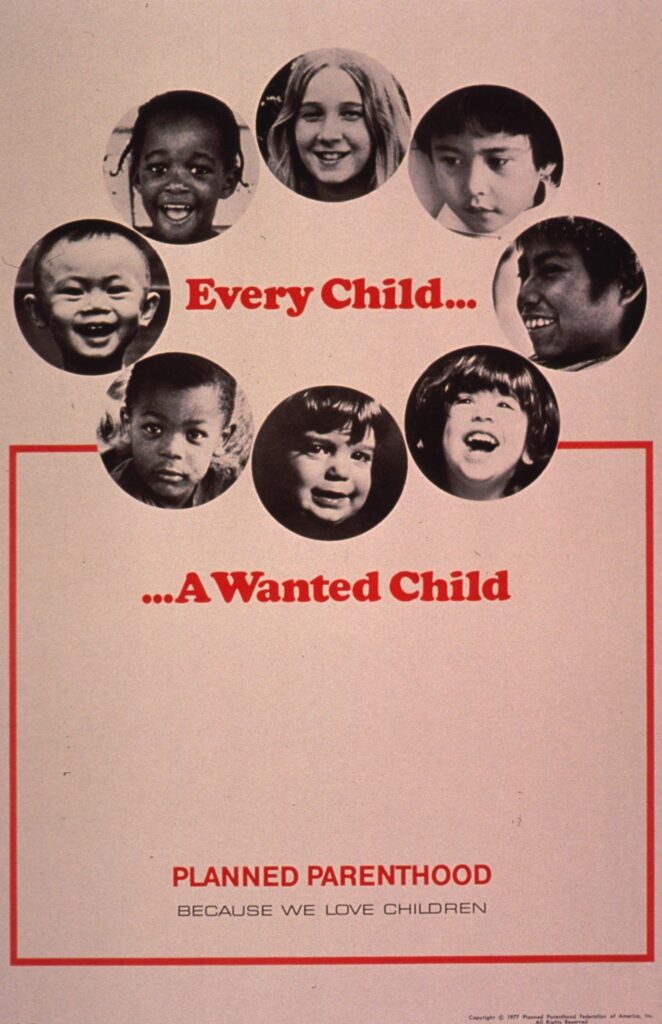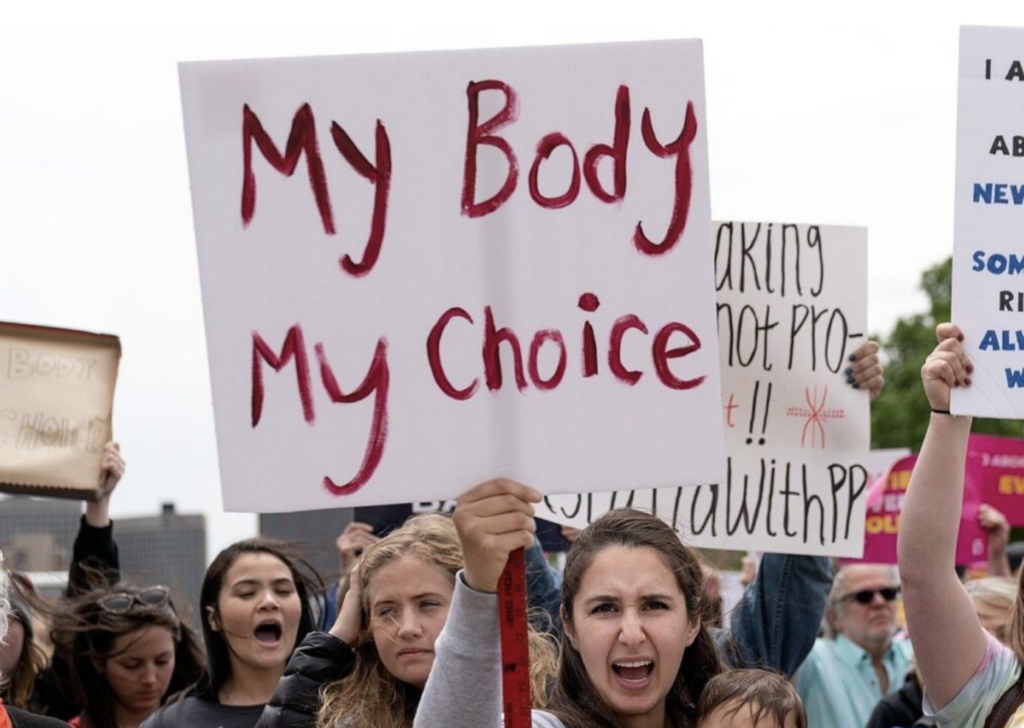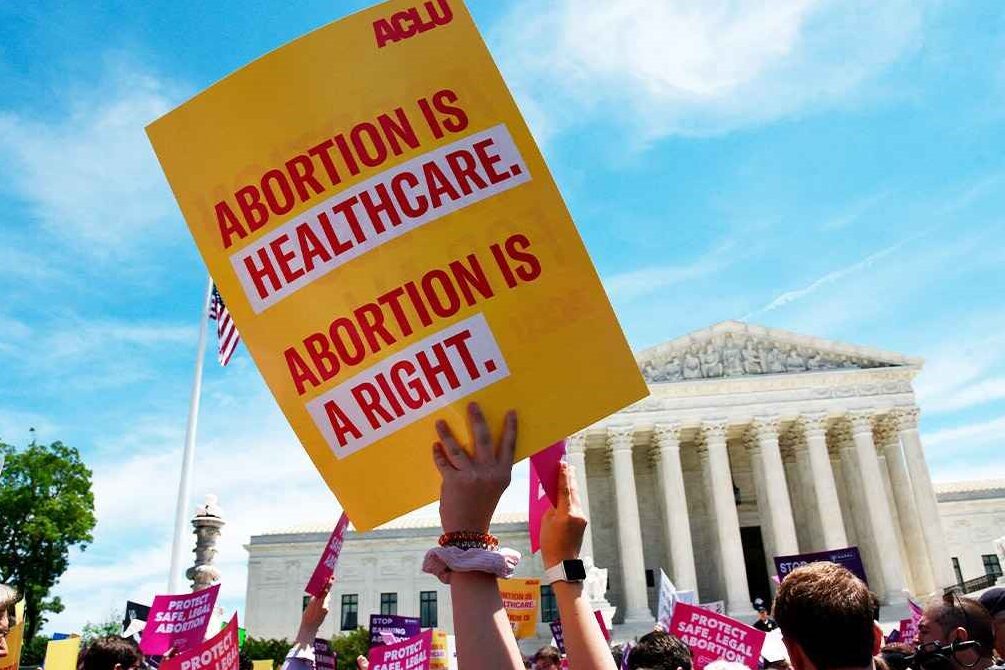
A slogan can be far more than a saying. When used wisely, a slogan can be the spark for productive debate. Slogans hold the power to pull citizens of vastly different backgrounds and beliefs to the ideological and political front lines. Slogans offer accessibility to the politically unengaged, compact complex arguments into an infectious format, and catalyze debate. Slogans are open access, democratic, artifacts of social consciousness and cultural memory in their most raw form.
From their beginnings in the early 20th century to the present day, pro-choice advocates and their organizations have made use of a variety of slogans: powerful, infectious rhetorical tools used to fight for, protect, and eventually mourn the loss of a woman’s right to an abortion in the United States. These slogans, along with the contexts of their usage, have evolved over time, from the days before 1973’s Roe v. Wade decision, to the roughly 50 years in which the decision was upheld, and to the present day in the wake of Dobbs v. Jackson. How exactly have popular slogans been used by pro-choice organizations and activists throughout history? How has the collective cultural memory of these slogans shifted over time and how might they continue to evolve in the near future?
Every Child a Wanted Child
Prior to Roe v. Wade, the pro-choice movement was driven by a dedicated, decentralized group of activists and organizations who sought to abolish restrictions on the practice [9]. It is key to note that during this time, groups faced opposition from both religious and medical organizations who viewed abortion as morally unjustifiable and deserving criminal association [2]. To combat these sentiments, pro-choice organizations sought highlight abortion’s supposed ability to solve social ills such as crime and poverty.
This line of thought gave birth to one of the period’s most well-recognized slogans: “Every Child a Wanted Child.”

This slogan, popularized by Planned Parenthood, painted a picture of the future that, on the surface, actually appealed to the period’s conservative social norms. The phrase implied abortion’s ability to eliminate out of wedlock births and therefore reinforce the nuclear family structure [10]. However, the cultural memory and employment of this slogan have evolved over time in line with shifts in attitude regarding the nuclear family since the 1970s. Today, criticism of the slogan’s implied condemnation of nontraditional family structures and out of wedlock births has led to a dramatic decrease in its use among contemporary abortion-rights activists [8].
Keep Abortion Legal | Keep Abortion Safe & Legal
After abortion was federally legalized by Roe, pro-choice proponents shifted rhetorical strategies over the coming decades, adopting slogans such as “Keep Abortion Safe and Legal” and “Keep Abortion Legal”. These slogans harnessed the memories of those who had lived during the Pre-Roe period. The generation of women who had first fought for the legalization of abortion feared a future regression where women would once again be forced to seek unsafe “back alley” abortions, putting their lives at serious risk [3]. It was this concern that these slogans sought to utilize.

Furthermore, these slogans aimed to establish abortion as a normative practice in American memory by placing emphasis on its legality and portraying abortion as something foundational to American society at large. However, since the overturning of Roe in 2022, this aspect of the phrases has been criticized [11]. Although powerful reminders of the dangers of illegal abortions prior to Roe v. Wade, the phrases were criticized by some within pro-choice circles for their defensive stance and narrow focus on the legality of abortion as opposed to a broader, more moralistic approach and justification [6].
My Body, My Choice
One such slogan that did seek a moral justification for abortion was “My Body, My Choice”, arguably the world’s most recognized slogan today.

The phrase, which first rose to prominence during the 1970s, made a succinct moral argument in favor of abortion access grounded on the moral pillars of self-determination and bodily autonomy. This slogan coincided with the period’s feminist groundswell which asserted women’s individuality and independence from traditional gender frameworks surrounding the family, individual finances, and the workplace [7]. During its reign as the world’s most widely disseminated pro-choice slogan, “My Body, My Choice” has faced a variety of hurdles. For instance, some thinkers assert that the phrase is excessively individualistic, failing to recognize or convey the broader societal benefits of reproductive freedom [4]. More recently, during the pandemic, the slogan was even hijacked by those opposing vaccine mandates [1]. Despite these obstacles and its current, ongoing evolution, “My Body, My Choice” remains frequently employed by organizations and individuals. It remains to be seen how the cultural memory of “My Body, My Choice” will shift in the wake of the pandemic and in the post-Roe era.
Then Dobbs happened.
Abortion Is a Right | Abortion Is Healthcare
Just prior to the 50th anniversary of the decision which established abortion as a legal right, the Supreme Court stripped away much of the federal protection Roe provided, affording state governments the ability to impose heightened restrictions on abortion access. In reaction to Dobbs and increased state restrictions, pro-choice advocates and organizations adapted, leaning more heavily into slogans such as “Abortion Is Healthcare” and “Abortion Is a Right”. These slogans aim to either emphasize the role of abortion as a necessary medical procedure or maintain the procedure’s status as a legally protected right, concepts that were engrained into the American consciousness during the Roe era [5].

Given how current these slogans are, their integration into American cultural memory is actively evolving. For some, they read as concrete, truthful statements while for pro-life opponents, the slogans offer little persuasion, appearing either innately false or morally blind to the existence of the unborn.
The slogans, phrases, and rhetorical tactics employed by pro-choice advocates have changed greatly over the past 75 years, reflecting American attitudes towards abortion, women’s reproductive rights, as well as broader social norms and expectations of the sexes. While some slogans such as “My Body, My Choice”, have remained poignant and frequently utilized to this day, others, such as “Every Child a Wanted Child” have increasingly been perceived as either outdated or even controversial. It is likely that the pro-choice movement and its slogans will continue to evolve and adapt to reflect and respond to changes in public opinion as well as the splintering and polarization of the American political and cultural landscape in the wake of Dobbs. The ways we remember the slogans of the past and present will too depend on the future of the broader American sociopolitical climate but also in the ways we actively choose to recall, analyze, and utilize them as integral parts of American cultural memory.
Ultimately, the effectiveness of slogans and pro-choice rhetoric will depend on their ability to reach those in the middle, mobilize supporters, and eventually have tangible impact on policy decisions related to reproductive rights.
– Luke Manna
Works Cited:
[1] Bluth, Rachel. “’My Body, My Choice’: How Vaccine Foes Co-Opted the Abortion Rallying Cry.” NPR, NPR, 4 July 2022, https://www.npr.org/sections/health-shots/2022/07/04/1109367458/my-body-my-choice-vaccines.
[2] Holland, Jennifer L. “Abolishing Abortion: The History of the pro-Life Movement in America.” The American Historian, https://www.oah.org/tah/issues/2016/november/abolishing-abortion-the-history-of-the-pro-life-movement-in-america/.
[3] Koerth, Maggie. “What the History of Back-Alley Abortions Can Teach Us about a Future without Roe.” FiveThirtyEight, FiveThirtyEight, 2 June 2022, https://fivethirtyeight.com/features/what-the-history-of-back-alley-abortions-can-teach-us-about-a-future-without-roe/.
[4] Lanphier, Elizabeth. “Is It Time to Retire the ‘My Body, My Choice’ Slogan?” FlaglerLive, 5 Aug. 2021, https://flaglerlive.com/body-my-choice-slogan/.
[5] Person, and Jan Wolfe Gabriella Borter. “Dueling Rallies as U.S. Supreme Court Confronts Abortion Rights Case.” Reuters, Thomson Reuters, 1 Dec. 2021, https://www.reuters.com/world/us/rallies-planned-us-supreme-court-hears-high-stakes-abortion-challenge-2021-12-01/.
[6] Ruffin, Alexis Lora. “The Social Construction of Abortion.” VCU Scholars Compass , Virginia Commonwealth University, 1992, https://scholarscompass.vcu.edu/cgi/viewcontent.cgi?article=5798&context=etd.
[7] “Second Wave Feminism: Collections.” Gale, Bloomington Women’s Liberation Newsletter, https://www.gale.com/primary-sources/womens-studies/collections/second-wave-feminism.
[8] Stacey, Judith. “The New Family Values Crusaders: Dan Quayle’s Revenge.” The Free Library, Farlex, 25 July 1994, https://www.thefreelibrary.com/The+new+family+values+crusaders%3A+Dan+Quayle%27s+revenge.-a015619132.
[9] Staggenborg, S. “The Survival of the pro-Choice Movement.” Journal of Policy History : JPH, U.S. National Library of Medicine, 1995, https://pubmed.ncbi.nlm.nih.gov/12346343/.
[10] Tarmann, Allison. “New Study Claims Abortion Is behind Decrease in Crime.” PRB, 1 Jan. 2000, https://www.prb.org/resources/new-study-claims-abortion-is-behind-decrease-in-crime/.
[11] Trumpy, Alexa J. “Fighting for Life: Pro-Woman Framing in the Pro-Life Movement .” OhioLINK, The Ohio State University , 2021, https://etd.ohiolink.edu/apexprod/rws_etd/send_file/send?accession=osu1306280819&disposition=inline.
Images
https://www.shutterstock.com/image-photo/woman-holding-blank-protest-sign-643939558
https://collections.nlm.nih.gov/catalog/nlm:nlmuid-101449609-img
[https://www.aclu.org/news/reproductive-freedom/for-justice-ginsburg-abortion-was-about-equality]
The first line of your introduction was proof enough for me that slogans can be so much more than a saying, as just your mention of slogans as a method to spark productive debate brought my mind to some of the most controversial slogans I have heard. My brain immediately connected your first point to Donald Trumps, “Make America Great Again” presidential campaign slogan that enacts a vastly different memory for citizens in America. When some see the slogan on a red hat they run in the other direction, some immediately prepare for heated debate, and some feel right at home with another Trump supporter. The slogan is most definitely a catalyst for debate just as the “My Body, My Choice” slogan can stir up discussion. As long as there is a divide in America between different ideologies, political or otherwise, slogans relating to the most “hot-hitting” topics such as abortion will always drive discussion. These slogans will enact different feelings and memories for individuals that have been around to see these issues come to face and will only continue evolving as long as there are still discussions about it.
I have never thought of slogans as a form of memory until this post. However, I realized it is easy for us to remember big-picture moments with slogans. The impact of a few select words can last for generations to come. Slogans become usable on signs during protests and even printed onto clothing. Sometimes, slogans can even be taken out of context. For example, Dr. King’s words have often been twisted to fit a neoliberal agenda while he was actually far more radical in reality.
I think it’s interesting how something such as a slogan can hold so much meaning, specifically the “my body my choice.” The development from the original Planned Parenthood slogan to the one commonly used today is very interesting to watch because with it, societies views on a women’s body and choices does and this is addressed in your paper. I think that a lot can be said about the power of a slogan, especially those associated with the abortion cause, because just one or two words can catapult decades of change.
Until reading this, I never thought of how the change in slogans were so representative of the movements at the time. It is very interesting to see new slogans emerge alongside the older, original slogans that started at the beginning of the movement. This can be seen as an example of processual memory. Seeing the slogans progress overtime allows for us to look back and see what things were top priority of the movement. It also allows us to directly see what has changed and and how the movement has shifted from the beginning until now.
I had not heard the slogan “every child…a wanted child” before reading this article. At first, I didn’t understand how it could be a pro-choice slogan as it sounds like a pro-life slogan advocating that every conceived child is wanted. After reading your description, I understood the issue with the slogan and how it may discriminate towards nontraditional families. I wonder how this slogan would have affected the movement and society in general if it was used for a longer time.
I find the slogan “Every child… …A wanted child” to be very interesting. I think the way in which the slogan was employed is also very intriguing because of other parts of our history that exist in our memory.
The poster utilizes pictures of children from multiple different races and ethnicities, which could impact the way in which people perceived the poster. It seems like the poster was put out sometime in the 1970’s, extremely close to the highly controversial ending of the Civil Rights Movement. How did the Civil Rights Movement affect how pro-choice slogans/posters were perceived by the American public?
It is interesting to ruminate about what makes an effective slogan. In my personal opinion, it should be short and sweet, to the point, and memorable. As we have been studying memory, it is safe to say that a memorable slogan will probably be on the daring side. It will probably make some sort of political statement that causes some internal reflection. In my opinion, these qualities are epitomized in the slogan “My Body, My Choice,” which you mentioned in this entry. At the very base, this slogan simplifies the abortion debate to its most elemental quality: its control over a [woman’s] body. Its message is simple, and it focuses on one aspect of the Roe vs. Wade conversation: the right to autonomy of the self. I think that its reuse during COVID with the vaccine debates is a great observation and example of the processual aspect of memory. This slogan could mean multiple things to different people depending on where they remember it most from. It is ironic that most people that might agree with legalized abortion would be pro-vaccine, but it goes to show just how different perspectives can be depending on how a piece of history is interpreted/remembered.
Great entry- I really enjoyed the eloquence and research that went into this. Awesome job!
As you point out, the perception of the memory of a slogan is dependent on its interpretation. Specifically, the “My Body My Choice” slogan is one of the most easily recognizable slogans of the pro-choice movement, but it is seen as morally irresponsible by the pro-life movement because it turns a blind eye to the other body affected by the choice. Language is a uniquely human gift; the ability to communicate rests on interpretation, and as a result the perception of a slogan can (positively or adversely) impact its memory.
It’s interesting to see how pro-choice slogans have evolved over time and how they have been employed strategically to shape cultural memory and political discourse around abortion. These slogans work to counter the anti-abortion narratives, which is interesting to think about how they were invented for that reason. As well as they were used to fight for, protect, and mourn the loss of a woman’s right to abortion
It is interesting to see the shift in cultural memory throughout the years. The change in slogans continuously highlights this shift. Slogans went from “Every child a wanted child” to “Keep abortions legal” then to “My body My choice.” The tones in the slogans changed overtime. The first slogan had a softer approach while the others had a more assertive approach. Another notable point from this post is how every slogan seemed to gain criticism from either sides of the debate. This goes to show that opposition will be faced no matter how justifiable a movement may be.
I never really thought until reading this article how important and iconic slogans are. I have had friends use “my body my choice” over a multitude of different situations but everyone knows it’s relationship to abortion. In today’s political climate I feel that “my body my choice” is most iconic as well as most present in arguments debating personal rights. I believe that this slogan is the one that’s going to stand the test of time in terms of presence and ease of recognition.
It’s fascinating to observe the evolution of pro-choice slogans over time and how they have been strategically employed to shape cultural memory and political discourse surrounding abortion. These slogans not only counter anti-abortion narratives but also serve as a means of fighting for, protecting, and mourning the loss of a woman’s right to choose.
I think it will be really interesting to see how the phrase “abortion is healthcare” is incorporated into the pro-choice narrative. Right now, I can’t see what a future issue with the slogan would be but also, I can find many issues with the “every child a wanted child” slogan and that was probably viewed positively by pro-choice advocates at the time. I think it also would be interesting to view the “every child a wanted child” without modern context or bias, because my first thoughts around that slogan didn’t connect it to abortion, and when I did make the connection, it seems to lend itself more to a pro-life argument.